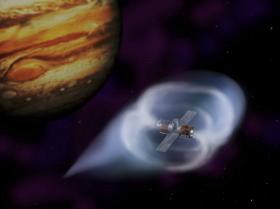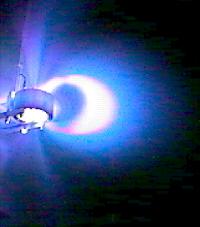Scientists from the University of Washington and NASA are experimenting
with miniature magnetospheres as an innovative form of space transportation.
by Dr. Tony Phillips
If a group of NASA-funded researchers have their way, parents in
the next century can breath a little easier. Every family saucer
will come equipped with a fuel-efficient magnetic bubble that speeds
its occupants from planet to planet and wards off the very worst
solar flares.
Most planets in the solar system already have such bubbles - they're
called magnetospheres. Earth's magnetosphere is an extension into
space of the familiar magnetic field that causes compass needles
to point North. Our planet sits at the heart of the bubble, which
occupies a volume at least 1000 times greater than Earth itself.
The magnetosphere protects us from solar wind gusts and from potentially
deadly solar flares. Without it, Earth might be as barren as Mars
or the Moon, two worlds without magnetospheres.
"The magnetosphere not only shields us from solar radiation but
it also acts something like a solar sail," says Dennis Gallagher,
a space physicist at the Marshall Space Flight Center. "The solar
wind pushes on the magnetosphere constantly, but fortunately Earth
is just too massive to blow away."
What might happen, though, if we created a magnetic bubble around
something much smaller than the Earth - like a spacecraft? Could
it ride the solar wind from planet to planet? Gallagher and his
colleagues think so.
"A 15 km-wide miniature magnetosphere one astronomical unit from
the Sun would feel 1 to 3 Newtons of force from the solar wind,"
says Gallagher, "That's enough to accelerate a 200 kg spacecraft
from a dead stop to 80 km/s (180,000 mph) in only 3 months.
"If we launched a space probe now equipped with such a bubble it
would easily overtake Voyager and become the first spacecraft from
Earth to cross the boundary into interstellar space."
The ingenious notion to use miniature magnetospheres as a form
of advanced propulsion was first suggested by Robert Winglee at
the University of Washington. The NASA Institute for Advanced Concepts
awarded Winglee a Phase I Revolutionary Advanced Concepts grant
two years ago followed by a Phase II contract, and already the idea
has leapt off the drawing board and into the lab.
"We've just finished our first round of tests in a 20 by 30 foot
vacuum chamber here at the Marshall Space Flight Center," says Gallagher,
the experiment's principal investigator at Marshall. "We're conducting
the tests as a cooperative effort between NASA and the University
of Washington, with support from the University of Alabama."
 NASA
NASA
An
artist's concept of a space probe riding a solar-wind driven
magnetic bubble past Jupiter.
|
"The magnetic field for our magnetosphere comes from a 1-ft diameter
coil of 16 gauge enameled wire. We run 5 to 30 amp currents through
the coil; that creates a 300 gauss field at the mouth of the solenoid"
- about 3 times stronger than a typical refrigerator magnet.
Normally, the intensity of such a magnetic field diminishes rapidly
with increasing distance from the coil. "It's similar to a dipole
field that falls off as the cube of the distance," explains Gallagher.
"Dipolar magnetic bubbles are a problem, though, because they don't
present the cross section we need to intercept plenty of solar wind
power."
To make the bubble bigger, Gallagher and his colleagues blew up
the magnetic field - much like inflating a balloon - by injecting
ionized gas near the coil. The innovative use of ionized gas (called
plasma) to blow up the magnetic bubble is what gives the project
its name: Mini-Magnetospheric Plasma Propulsion or M2P2 for short.
"The thing that makes M2P2 special is that we inflate the field
from the inside with low-energy plasma," says Gallagher. "Earth's
magnetosphere is inflated with plasma, too, but it's not as dense
as the plasma inside the M2P2 bubble. Jupiter's magnetosphere comes
closer - the sources of plasma there are active volcanoes on Io."
The Marshall scientists use a more down-to-Earth plasma source
for their M2P2 experiments - a helicon plasma generator, which ionizes
gaseous argon and helium with high-power radio waves. "Helicons
are fairly common," noted Gallagher. They are routinely used for
fundamental plasma research and to etch commercial semiconductors.
"Last week's test was a success. We were able to completely fill
the vacuum chamber with a magnetic bubble. The only thing that stopped
the expansion was the presence of the chamber walls. In space this
same experiment might create a mini-magnetosphere 15 km across."
Maintaining such a bubble in space would require about 1 kW of
power and less than 1 kg per day of helium propellant for the plasma
source. In return, the bubble would intercept about 600 kW of solar
wind power.
"One of the advantages of M2P2 is that it requires no new technology,"
says Gallagher. "The plasma sources and solenoids at the heart of
the bubble are off-the-shelf devices."
"M2P2 is a 'constant-force' device," he added. "And that's another
big advantage. If you sail the spacecraft far from the Sun, you
won't lose thrust." How can that be?
 NASA
NASA
A
luminous plasma plume inflates an invisible magnetic bubble
inside the vacuum chamber at NASA's Marshall Space Flight
Center.
|
The force exerted on a magnetic bubble depends on how big it is.
Big bubbles intercept more solar wind than little ones do and thus
lend greater thrust to the spacecraft inside. Bubbles that travel
away from the Sun naturally expand as the solar wind pressure plummets.
They grow for the same reason that a child's balloon inflated at
sea level will expand in rarefied air at high-altitudes.
"The sizes of balloons and of magnetic bubbles are set by the same
thing - a balance of internal and external pressures," says Gallagher.
"For M2P2, the internal pressure comes from the plasma and the solenoidal
magnetic field. The external pressure is the solar wind."
The solar wind's force per unit area decreases as the square of
the distance from the Sun. Doubling the distance, for instance,
decreases the solar wind pressure by a factor of four. "The solar
wind is weaker far from the Sun, but the bubble is bigger, too (precisely
because the solar wind pressure is lower)," he continued. "It so
happens that the cross section of the bubble increases by the same
factor that the solar wind pressure declines. The two effects completely
cancel." It seems amazing, but the propulsive thrust of an M2P2-powered
craft remains the same whether the spacecraft is near the Sun or
in the outer reaches of the solar system.
For human travelers the greatest advantage of M2P2 might not be
steady acceleration or fuel efficiency, but rather its impressive
safety features. Just as the Earth's magnetosphere protects us from
solar radiation, an M2P2 bubble could shield spacefarers from cosmic
rays and solar flares.
 NASA
NASA
An
artist impression of the solar winds.
|
"The magnetic shielding idea needs to be investigated more carefully,"
noted Gallagher, "but it looks promising. By chaining multiple M2P2
units together on the same spacecraft, we should be able to minimize
plasma losses and end up with a better cosmic ray shield as a bonus."
"I like to think of M2P2 as the first externally-powered fusion
engine," he concluded. "The engine is the Sun itself - M2P2 bubbles
just ride along on the exhaust."
The next round of M2P2 tests is slated for 2001. Buoyed the success
of the ongoing lab experiments (and, of course, by the solar wind)
magnetic bubbles could well become the space carriage of choice
for the next century.
|
